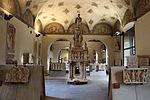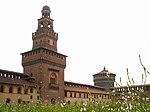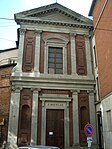Castello Sforzesco
Archaeological museums in ItalyArt museums and galleries in LombardyBrick buildings and structuresBuildings and structures in MilanCastles in Lombardy ... and 9 more
Culture in MilanDecorative arts museums in ItalyEgyptological collections in ItalyHouse of SforzaMuseums in MilanMusic museums in ItalyRenaissance architecture in MilanSforza CastleTourist attractions in Milan

The Castello Sforzesco (Italian for "Sforza's Castle") is a medieval fortification located in Milan, northern Italy. It was built in the 15th century by Francesco Sforza, Duke of Milan, on the remnants of a 14th-century fortification. Later renovated and enlarged, in the 16th and 17th centuries it was one of the largest citadels in Europe. Extensively rebuilt by Luca Beltrami in 1891–1905, it now houses several of the city's museums and art collections.
Excerpt from the Wikipedia article Castello Sforzesco (License: CC BY-SA 3.0, Authors, Images).Castello Sforzesco
Piazza Castello, Milan Municipio 1
Geographical coordinates (GPS) Address Website External links Nearby Places Show on map
Geographical coordinates (GPS)
| Latitude | Longitude |
|---|---|
| N 45.47 ° | E 9.1786111111111 ° |
Address
Castello Sforzesco
Piazza Castello
20121 Milan, Municipio 1
Lombardy, Italy
Open on Google Maps










